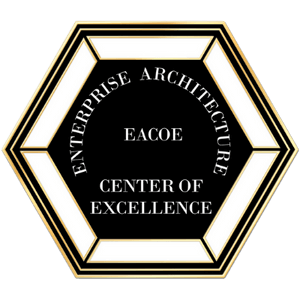EACOE’s Portfolio Optimization Process
Step 1: Present Education Orientation on Application Portfolio Optimization
Recruit Project Participants
Develop Project Schedule
Review Optimization Approach
Present Education and Training
Review Case Study Example for Guidance
Step 2: Assemble Application Inventory Information
Review Application Inventory Field Definitions
Scope Initial Effort – Optimization Only or Complete Application Health Check and Optimization
Review Initial Application Inventory List
Identify Location of Key Documentation
Identify System Customers and Developers
Step 3: Develop Enterprise Process Model
Gather Process Sources (documents, presentations, sources, etc.)
Identify Processes
Define Processes
Build Process Model (Taxonomy and Definitions)
Verify Process Model with Key Or Stakeholder Personnel
or
Use the EACOE Process Model as a “quick start” approach to Portfolio Optimization (EACOE Process Model has approximately 2,000 Process Names and Process Definitions
Step 4: Inventory Applications
Conduct Documentation Reviews
Conduct Developer and Support Interviews (optional)
Conduct Customer Interviews (optional)
Draft Application Health Check Assessment (if conducting a Health Check)
Step 5: Document Application Inventory Results
Review Ratings for Consistency
Publish Application Inventory Heath Check Results
Step 6: Develop Process to Application Relationship Map
Determine Proper Granularity Level for Process Mapping
Map Processes to Applications
Determine Application that contains “Process of Record”
Analyze Mapping
Step 7: Determine Applications for Retirement
Define Criteria for Retirement
Define Criteria for Optimization – the Characteristics that will Define Optimization
Apply Optimization Criteria
Identify Candidate Applications for Retirement
Map Optimized Applications to Enterprise Processes
Step 8: Retire Applications
Using the Application Health Check (if developed), Identify Affected Customers
Educate and Train Customers in the use of the Optimized Applications
Map Candidate Applications for Retirement Against Optimized Applications
Determine the Source of Processes that Remain in the Candidate Applications for Retirement, and Determine the Application that can/ will Contain this Process
Determine that the Candidate Application for Retirement has no Processes Remaining that are not Contained within the Optimized Applications
Define Retirement Process and Sequence
Retire Application
Recap Massive Savings
Deploy Savings to the Architecture Teams to Prevent Future “De” Rationalization

